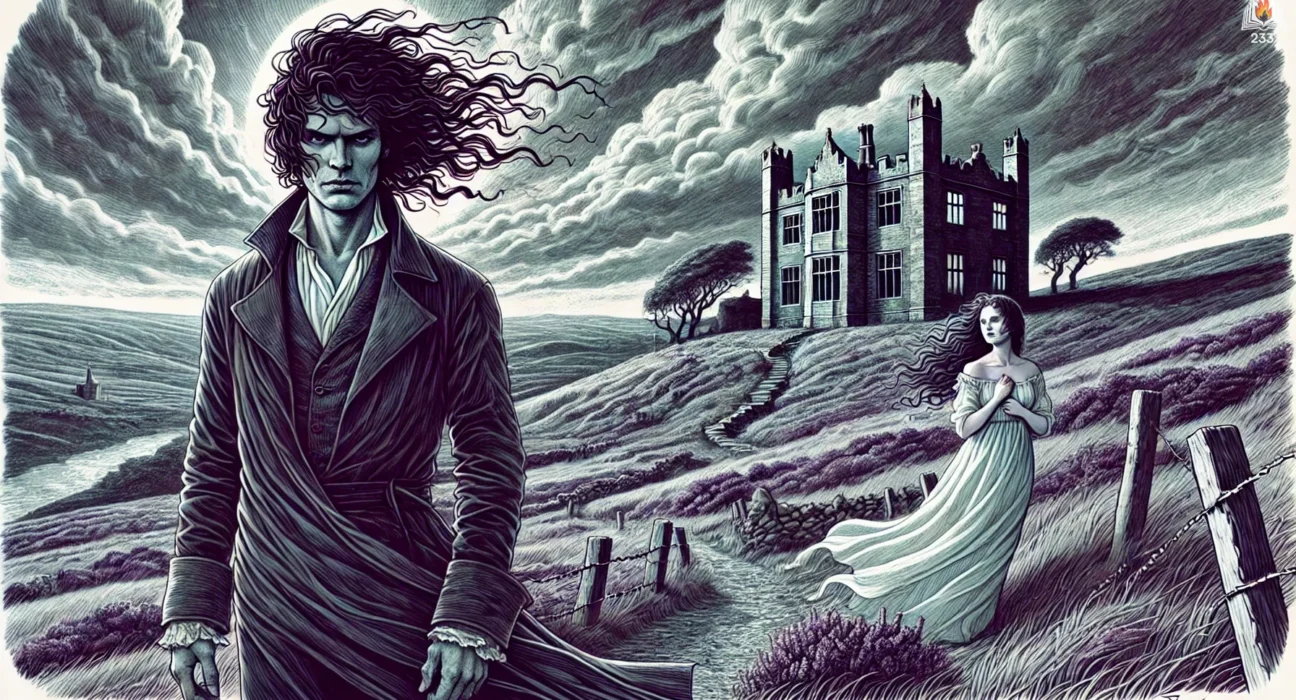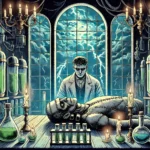Wuthering Heights, written by Emily Brontë and published in 1847, is a dark and powerful Gothic novel that explores intense emotional landscapes and the destructive power of love, vengeance, and obsession. The story is set on the remote moors of northern England, where the intertwined lives of two families, the Earnshaws and the Lintons, unfold over several generations. Heathcliff, the brooding anti-hero, takes center stage in a tale that blurs the lines between love and hatred, life and death.
Plot Summary
On the cold, desolate moors of northern England stood Wuthering Heights, a brooding, wind-swept estate, where Mr. Lockwood, a new tenant at the nearby Thrushcross Grange, made an ill-advised visit to meet his landlord, the grim and mysterious Heathcliff. The residents of Wuthering Heights, with their savage dogs and inhospitable nature, left Lockwood bewildered. But it was the strange, dark figure of Heathcliff, a man who exuded both bitterness and sorrow, that piqued his curiosity.
After a stormy night, Lockwood fell ill and spent time at Thrushcross Grange, cared for by the housekeeper, Nelly Dean. Seeking entertainment, he asked Nelly to recount the history of Wuthering Heights and its inhabitants. Her tale wove a dark and tangled web, reaching back decades, when Mr. Earnshaw, the master of Wuthering Heights, brought home an orphaned boy from the streets of Liverpool. That boy was Heathcliff.
From the moment of Heathcliff’s arrival, the dynamics at Wuthering Heights shifted. Young Catherine Earnshaw, wild and untamed as the moors themselves, formed an immediate bond with him, while her brother, Hindley, grew resentful, furious at their father’s affection for this stranger. As the years passed, Heathcliff and Catherine’s bond deepened, not just as friends but as kindred spirits—two souls fiercely united by their shared passion for freedom and rebellion. Yet, this intense love was also their undoing. Hindley, after inheriting the estate upon his father’s death, sought to degrade Heathcliff, turning him into little more than a servant.
Despite the cruelty he endured, Heathcliff’s love for Catherine never waned. But Catherine’s ambitions wavered. In a fateful decision, she chose to marry Edgar Linton, the refined and gentle young man from Thrushcross Grange, believing that such a match would elevate her socially. Yet, in her heart, she knew her true soul belonged to Heathcliff. It was not long after her confession that Heathcliff, overhearing her dismissal of him as beneath her, vanished from Wuthering Heights, leaving Catherine bereft and regretful.
Years passed, and Heathcliff returned, not as the destitute boy who had left, but as a wealthy, powerful man. With his return, a dark storm settled over both Wuthering Heights and Thrushcross Grange. Heathcliff had not come back simply for love; he sought revenge. His first act of vengeance was to take control of Wuthering Heights, exploiting Hindley’s weaknesses and reducing him to a broken, drunken man. But Heathcliff’s thirst for retribution extended beyond Hindley. His cold, calculated marriage to Isabella Linton, Edgar’s innocent sister, was a means of further tormenting those he despised. Isabella, captivated by Heathcliff’s brooding allure, soon discovered the cruelty that lay beneath his surface, suffering through a brutal, loveless marriage.
Catherine, already fragile, became increasingly tormented by the toxic proximity of Heathcliff and Edgar. Torn between the man she had married and the man she could never truly let go of, her health rapidly deteriorated. She grew hysterical, consumed by a fevered longing for the freedom of her youth, for the wild days she had spent with Heathcliff on the moors. Eventually, this inner turmoil led to her death, shortly after giving birth to her daughter, Cathy Linton.
Catherine’s death shattered Heathcliff. Though he had achieved much of his vengeful goals, nothing could fill the void left by her absence. He became even more bitter and malevolent, lashing out at those around him. Heathcliff’s wrath extended to the next generation. He treated Hindley’s son, Hareton Earnshaw, with the same cruelty that he had once endured, raising him in ignorance and servitude, denying him any education or gentleness. At the same time, Cathy Linton, the mirror image of her mother in both beauty and spirit, grew up at Thrushcross Grange under Edgar’s loving care, unaware of the dark shadows of Wuthering Heights that loomed so near.
As fate would have it, Cathy’s life became entwined with Wuthering Heights when she met Linton Heathcliff, the sickly and spiteful son of Heathcliff and Isabella. In a cruel manipulation, Heathcliff orchestrated a marriage between Linton and Cathy, intending to secure his final act of vengeance—claiming both Thrushcross Grange and Wuthering Heights. Linton, however, was frail and died shortly after the marriage, leaving Cathy at the mercy of Heathcliff’s control.
Yet, amid the desolation and cruelty, a glimmer of hope remained. Cathy, with her fiery spirit, found an unexpected connection with Hareton, the rough and uneducated young man who had been degraded by Heathcliff. Despite his brutish upbringing, Hareton possessed a quiet dignity and strength, and under Cathy’s influence, he slowly began to reclaim his rightful place as an Earnshaw. Their blossoming love marked a chance for redemption, an opportunity to break the cycle of hatred that had plagued both families for so long.
As Heathcliff descended further into madness, haunted by the ghost of Catherine and his own unrelenting grief, he lost interest in his worldly gains. Wuthering Heights, once the symbol of his revenge, became a tomb. Obsessed with the idea of being reunited with Catherine in death, Heathcliff’s will to live ebbed away, and he was found dead in her old room, as if finally succumbing to the overwhelming pull of their tragic love.
In the aftermath of Heathcliff’s death, the storm that had long hung over Wuthering Heights began to clear. Cathy and Hareton, representing the new generation, were free to rebuild their lives, leaving behind the legacy of vengeance that had consumed their families. Together, they sought peace and harmony, paving the way for the possibility of love and happiness to return to the moors.
Main Characters
Heathcliff: The central figure of Wuthering Heights, Heathcliff is introduced as an orphan brought into the Earnshaw family. His personality is marked by his mysterious origins, a capacity for deep love, and an equally fierce thirst for vengeance. His obsessive love for Catherine Earnshaw shapes the trajectory of his life, driving him to cruelty and destruction after she marries Edgar Linton.
Catherine Earnshaw (Cathy): Spirited and passionate, Catherine is Heathcliff’s soulmate but also his greatest torment. Torn between her love for Heathcliff and her desire for social advancement through marriage to Edgar Linton, her divided loyalties lead to personal tragedy. Her untimely death fuels Heathcliff’s obsession with revenge.
Edgar Linton: Edgar is Catherine’s husband and Heathcliff’s rival. He is gentle, refined, and kind, embodying the opposite of Heathcliff’s dark, violent nature. Despite his love for Catherine, he is ultimately unable to compete with the intensity of her connection to Heathcliff.
Isabella Linton: Edgar’s sister, who falls in love with Heathcliff, not realizing the depth of his cruelty. She becomes his wife but soon suffers from his abusive and vindictive nature.
Hindley Earnshaw: Catherine’s brother, Hindley’s hatred of Heathcliff stems from jealousy after his father favors the orphaned boy. Hindley’s cruelty towards Heathcliff during their youth fuels Heathcliff’s later desire for revenge against the Earnshaw family.
Hareton Earnshaw: The son of Hindley, Hareton is raised in ignorance and brutality by Heathcliff as part of his revenge. Despite his rough upbringing, Hareton shows potential for kindness and redemption, especially through his relationship with Cathy Linton.
Cathy Linton (Catherine’s daughter): The daughter of Catherine and Edgar, she inherits her mother’s beauty and spirit but is raised more gently by her father. Her eventual bond with Hareton hints at the possibility of healing the rifts between the two families.
Theme
The Destructive Power of Love and Revenge: The novel presents love in its most extreme and destructive forms. Heathcliff’s love for Catherine transforms into an obsessive force that drives him to cruelty and vengeance against those who stand in his way. This vengeful love also destroys his own happiness, as his fixation on Catherine’s memory prevents him from finding peace.
Social Class and Power: Class distinctions play a significant role in shaping the characters’ relationships. Catherine’s decision to marry Edgar, despite her love for Heathcliff, reflects her desire to ascend socially. Heathcliff’s pursuit of power, both financially and socially, is driven by his earlier subjugation as an orphan and outsider in the Earnshaw household.
Nature and the Supernatural: The novel is steeped in Gothic elements, where the wild, untamed moors serve as a reflection of the characters’ passions and untethered emotions. The supernatural, particularly the idea of ghosts, is woven throughout the narrative, with Catherine’s spirit seemingly haunting Heathcliff after her death, symbolizing their unresolved connection.
Isolation: Both physical and emotional isolation pervade the novel. Wuthering Heights itself is remote and desolate, mirroring the emotional isolation of its inhabitants. Characters like Heathcliff and Cathy experience profound loneliness, as their deepest desires remain unfulfilled, trapping them in cycles of alienation and revenge.
Writing Style and Tone
Emily Brontë’s writing style in Wuthering Heights is notable for its vivid, almost poetic descriptions of the wild moors and the intense emotions of the characters. Brontë employs a layered narrative structure, with the story being told through multiple narrators, most notably Mr. Lockwood and Nelly Dean. This method adds complexity to the storytelling, as readers must interpret the events through the biases and perspectives of these narrators. The language Brontë uses is often dense and rich with Gothic imagery, enhancing the sense of foreboding and doom that hangs over the novel.
The tone of Wuthering Heights is dark, brooding, and melancholic. Brontë creates an atmosphere of emotional turmoil and existential despair, particularly through the character of Heathcliff. The novel’s intense focus on destructive passions and the consequences of unchecked emotion gives it a dramatic, almost tragic quality. However, there are moments of tenderness and hope, particularly towards the end of the story, as the next generation—Cathy and Hareton—offers a glimpse of potential redemption.
We hope this summary has sparked your interest and would appreciate you following Celsius 233 on social media:
There’s a treasure trove of other fascinating book summaries waiting for you. Check out our collection of stories that inspire, thrill, and provoke thought, just like this one by checking out the Book Shelf or the Library
Remember, while our summaries capture the essence, they can never replace the full experience of reading the book. If this summary intrigued you, consider diving into the complete story – buy the book and immerse yourself in the author’s original work.
If you want to request a book summary, click here.
When Saurabh is not working/watching football/reading books/traveling, you can reach him via Twitter/X, LinkedIn, or Threads
Restart reading!








